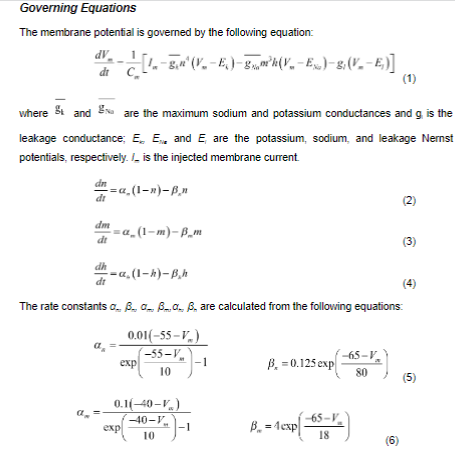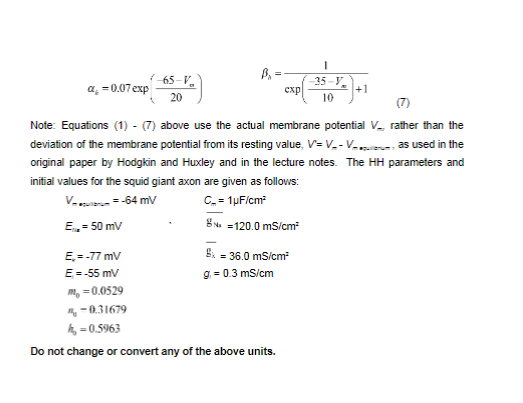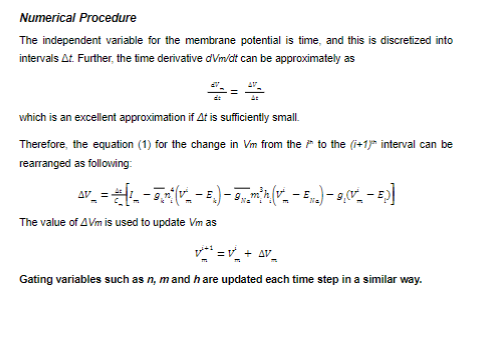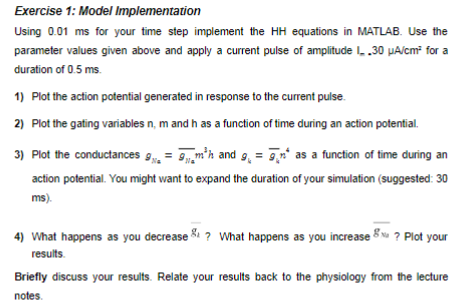Answer exercise one using matlab please thanks
The aim of this laboratory is to implement the classic Hodgkin-Huxley model of the()1 giant squid nerve action potential as a numerical simulation in Python or MATLAB. You will use your model to conduct a series of simulation studies to explore some of the characteristics of nerve excitation. The steps involved are as follows: 1. Arrange the differential equations describing the Hodgkin-Huxley model into a set of programmable equations. 2. Implement these equations in MATLAB, Python or a programming language of your choice. You are encouraged to use Python for this assignment as familiarity with the language will be beneficial for Lab 2. 3. Conduct a series of simulation experiments to explore neuronal dynamics. Hodgkin-Huxley Model For the purposes of this laboratory, we will consider the excitation of a section of membrane in a space-clamped cell for which the transmembrane voltage is allowed to vary as a function of time, but not space. This model can be later extended to incorporate propagation along the nerve fibre if required.
1. Hodgkin, A., and Huxley, A. (1952): A quantitative description of membrane current and its application to conduction and excitation in nerve. J. Physiol.117:500544.
The behaviour of the HH model is fully described by four state variables: the membrane voltage, Vm, the potassium activating parameter, n, and the sodium activating and inactivating parameters, m and h. The behaviour of each variable is described by an ordinary differential equation, (1)-(4) below. Having solved for the initial conditions, the differential equations can be incorporated into an iterative time-loop and solved at each time step using numerical methods (e.g. finite difference method, Eulers method, Crank-Nicholson method etc.).



The question

Governing Equations The membrane potential is governed by the following equation: [L-8' (V.,-E)-8(V- Ess)-8:(V. - )] dV dr EwEwH4VE (1) where St and as are the maximum sodium and potassium conductances and g is the leakage conductance: E. E, and E are the potassium, sodium, and leakage Nernst potentials, respectively. 1_ is the injected membrane current din dr =,(1-2)-B.11 (2) dme dit "-2 (1-m)-B_m (3) - a, (1-1)-B, 1 The rate constants o_B_C_B_.aB. are calculated from the following equations: 0.014-55-V.) a -55-V (-65-V, Y exp -1 B = 0.125 exp 10 (5) 80 0.1(49-V) -40- exp -1 10 -65-V. B. = 10p 18 (6) 65-V. B = cxp a = 0.07 exp 1 35-Y 10 +1 20 Note: Equations (1) - (7) above use the actual membrane potential V. rather than the deviation of the membrane potential from its resting value, V=V-V. as used in the original paper by Hodgkin and Huxley and in the lecture notes. The HH parameters and initial values for the squid giant axon are given as follows: V=-64 mv Cu = 1F/cm E = 50 mV S = 120.0 mS/cm E =-77 mv B = 36.0 mS/cm E =-55 mv 9 = 0.3 mS/cm m = 0.0529 4-0,31679 Is=0.5963 Do not change or convert any of the above units. Numerical Procedure The independent variable for the membrane potential is time, and this is discrefized into intervals At Further, the time derivative dVm/at can be approximately as which is an excellent approximation if At is sufficiently small. Therefore, the equation (1) for the change in Vm from the P to the (i+19 interval can be rearranged as following: -V = 02-7715 - 5.) - oma( -_.-8.V.-=>] The value of Vim is used to update Vm as ** = V + AV Gating variables such as n, mand hare updated each time step in a similar way. Exercise 1: Model Implementation Using 0.01 ms for your time step implement the HH equations in MATLAB. Use the parameter values given above and apply a current pulse of amplitude L.30 Alcm for a duration of 0.5 ms. 1) Plot the action potential generated in response to the current pulse. 2) Plot the gating variables n, m and has a function of time during an action potential. 3) Plot the conductances 9 = 9mh and 9, = n* as a function of time during an 9 action potential. You might want to expand the duration of your simulation (suggested: 30 ms). 4) What happens as you decrease ? What happens as you increase 8 ? Plot your results Briefly discuss your results. Relate your results back to the physiology from the lecture notes Governing Equations The membrane potential is governed by the following equation: [L-8' (V.,-E)-8(V- Ess)-8:(V. - )] dV dr EwEwH4VE (1) where St and as are the maximum sodium and potassium conductances and g is the leakage conductance: E. E, and E are the potassium, sodium, and leakage Nernst potentials, respectively. 1_ is the injected membrane current din dr =,(1-2)-B.11 (2) dme dit "-2 (1-m)-B_m (3) - a, (1-1)-B, 1 The rate constants o_B_C_B_.aB. are calculated from the following equations: 0.014-55-V.) a -55-V (-65-V, Y exp -1 B = 0.125 exp 10 (5) 80 0.1(49-V) -40- exp -1 10 -65-V. B. = 10p 18 (6) 65-V. B = cxp a = 0.07 exp 1 35-Y 10 +1 20 Note: Equations (1) - (7) above use the actual membrane potential V. rather than the deviation of the membrane potential from its resting value, V=V-V. as used in the original paper by Hodgkin and Huxley and in the lecture notes. The HH parameters and initial values for the squid giant axon are given as follows: V=-64 mv Cu = 1F/cm E = 50 mV S = 120.0 mS/cm E =-77 mv B = 36.0 mS/cm E =-55 mv 9 = 0.3 mS/cm m = 0.0529 4-0,31679 Is=0.5963 Do not change or convert any of the above units. Numerical Procedure The independent variable for the membrane potential is time, and this is discrefized into intervals At Further, the time derivative dVm/at can be approximately as which is an excellent approximation if At is sufficiently small. Therefore, the equation (1) for the change in Vm from the P to the (i+19 interval can be rearranged as following: -V = 02-7715 - 5.) - oma( -_.-8.V.-=>] The value of Vim is used to update Vm as ** = V + AV Gating variables such as n, mand hare updated each time step in a similar way. Exercise 1: Model Implementation Using 0.01 ms for your time step implement the HH equations in MATLAB. Use the parameter values given above and apply a current pulse of amplitude L.30 Alcm for a duration of 0.5 ms. 1) Plot the action potential generated in response to the current pulse. 2) Plot the gating variables n, m and has a function of time during an action potential. 3) Plot the conductances 9 = 9mh and 9, = n* as a function of time during an 9 action potential. You might want to expand the duration of your simulation (suggested: 30 ms). 4) What happens as you decrease ? What happens as you increase 8 ? Plot your results Briefly discuss your results. Relate your results back to the physiology from the lecture notes










